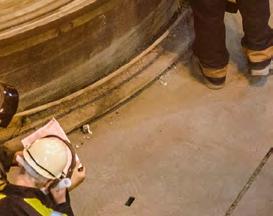
4 minute read
Modernising security
Why the connected officer is driving security transformation
For many years, too many people have associated security with disengaged officers, offering a limited set of skills and reluctantly performing and recording a minimum set of daily tasks.
While customers may have been aware of these flaws, many have not prioritised security and, as a result, their security has continued in the same shape and design over lengthy periods, becoming outdated and ineffective.
Common complaints have included security being too reactive to incidents or providing limited and inadequate service delivery reporting. The officers themselves often cite a sense of loneliness, with an under investment in training and development and lack of connection to their head office and colleagues leading to their disengagement.
However, with the post pandemic environment acting as a catalyst, organisations are now demonstrating a much greater appetite to modernise security.
Noah Price, G4S Academy International Director, outlines how the role of security is changing and how its Connected Officer Programme is delivering service improvement, workforce engagement and the delivery of safer environments by leveraging technology advancements whilst maintaining personal interaction.
Today’s security consumers demand a proactive, data-driven, intelligent, and informed approach to operational delivery. Security providers must supply their customers with clear and transparent performance data in real time, to drive better decision making.
So how is security responding?
G4S’ Connected Security Officer programme is emerging as the key enabler. Significantly, this technology-enabled programme still operates with people at the core, but uses technology to drive the service improvement and staff engagement that the modern environment demands.
The programme is already well embedded within some significant security operations, such as the UK’s largest public services department, where the programme has been rolled out to officers operating across 800 UK sites.
Importantly, the programme is just as relevant for small and medium sized businesses, who require improvements to security, but on a much smaller scale.
What does a Connected Officer Look Like?
A Connected Officer’s appearance will vary depending on the environment in which they work. In some cases, wearable technology will be obvious to the public and for good reason. A first responder may appear bionic, given the multiple devices that they could be wearing, such as body-worn cameras with a visible screen, smart weapons and heads up displays. But in a corporate reception, where officers are expected to balance their security function with customer service, the officer may wear technology that is less apparent to the public, such as smart watches, tablets and augmented reality glasses that look like everyday eyeglasses.
What Benefits Does the Connected Officer Programme Bring?
-Officer Engagement and Development
Security officers are selected for their specific personality traits, that range from leadership and courage to compassion and patience. These human traits are what allow officers to greet visitors in one moment and deter criminals the next. Technology can’t have a conversation with another human to determine if they are a potential risk or provide a warm front of house greeting.

So, whilst the security officer remains key, the programme uses technology to support the officer by providing simple and easy access to a network of colleagues and learning and development materials - all driving more engagement and motivation.
Through a tablet or appropriate smart device, the officer can access formal training, bulletins and even company updates and news - supporting their development, engagement and preventing disassociation and frustration.
-Providing Data Driven Performance nsight
The benefits of the Connected Officer programme are far from limited to the officers themselves. By using their handheld device to record all activities, data is captured centrally. Information captured from officers operating across multiple locations can be consolidated into simple and easy to consume reporting - all accessed from a central location.
Any customer that oversees security across multiple locations can view key information, such as performance notifications, at the click of a button. They have real time insight to drive better decision making.
Common areas of monitoring include validating that key tasks have been completed in accordance with the contract service level agreement, and in compliance with regulatory requirements and that shifts have been fulfilled. Customers can also review an archive of reported incidents to assess trends.
-Performance Improvement
This data insight leads to resource optimisation and a real focus on service performance improvement, and the Connected Officer Programme has real operational benefits too.
A real time connection to a command and control function makes use of developments in artificial intelligence to identify potential incidents before they occur. Unusual motion and activity is flagged in real time, allowing officers to proactively investigate incidents, armed with key information, rather than waiting for incidents to be reported, when it is often too late.
When an incident does occur, the Connected Officer programme provides instant officer location visibility to command and control. This means that the most appropriate officer is tasked with attending the scene and can be briefed on any potential threats in advance, so they are fully prepared to provide an appropriate response. Speed of response is critical in an emergency and this saves precious time.
-Creating a Safer Environment
We have seen the Connected Officer Programme have huge safety benefits in sectors where violence and aggression is prevalent, such as hospitals, retail and other public facing roles.
The presence of body-worn cameras, as part of the connected offering, has been proven to lead to a noticeable change in the way that the public interact with securityoften quickly appeasing hostile and aggravated incidents, once people become aware that they are being recorded.
-A Sustainable Approach
The environment itself benefits too. With paper reported to account for around 26% of total waste at landfill, the elimination of paper-based reporting provides significant sustainability benefits. In addition, as less paper is consumed, precious storage space is freed up, meaning less energy is consumed.
What’s Next?
As artificial intelligence and natural language processing progress, we will see increased adoption of virtual officers, which will operate in a similar manner to mobile assistants such as Apple’s Siri, Amazon’s Alexa, IBM’s Watson Assistant and
Microsoft’s Cortana.
As an example, a connected security officer will engage their radio or mobile device and ask the assistant to run a license plate. The system will query the incident and case management software, or any of our other enterprise systems. It will be an officer’s virtual partner.

During one of the most transformational times in human history, technology is vital, and G4S will always use it to support its security officers. The future focus of the Connected Officer Programme will be to maintain the right balance between leveraging technology advancement and maintaining personal security interaction.
Noah Price is International Director of the G4S Academy which is responsible for sharing specialist threat and security knowledge. It provides regular, free security bulletins on potential threats, which can be a useful part of security planning.
For further information, please visit www.g4s.com/en-gb/what-we-do/ academy









































